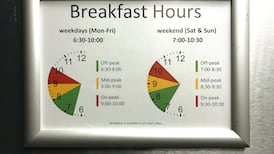One hundred years ago Ireland’s defence against the world consisted of our distance and their disinterest. Neither holds true now.
About 65 per cent of Europe’s communications cables run through Irish waters. Our energy security requires an 83km subsea high-pressure gas pipeline from the Corrib gas field and the EirGrid East-West electricity Interconnector from north Dublin to north Wales. Another, to France, is planned. Developing renewable energy on scale requires further interconnection under the sea. It’s a vast space, neither above nor below which do we have the capacity to see clearly or act effectively.
The Russian navy’s feint off the southwest coast this year was to demonstrate their capacity to close a ring around Europe and potentially fire missiles into any part of the continent. It showed what could be done and unsettled nerves accordingly.
The aviation control centre at Shannon handles 90 per cent of all air traffic over the north Atlantic. That was more than 1,400 hundred aircraft every 24 hours last summer. There were in excess of 180,000 overflights of Irish airspace as well and these figures are below their pre-Covid peak. It’s busy up there, but unbelievably the Defence Forces have no capacity to see aircraft that do not wish to be detected. All commercial aircraft, as a matter of safety and legal obligation, have an onboard transponder that signals its position to air traffic control. This is known as secondary radar.
Presidential election: Four things Humphreys and Connolly should do in final days
Sinn Féin has placed a foot in every camp. No wonder it’s wobbling
We cannot police the streets if online material is not regulated
The EU status quo Ireland prospered in for 50 years is at an end. We need to cop on and catch up quickly
An aircraft that doesn’t wish to be detected and turns off its transponder is virtually invisible to the Defence Forces because they have no long-range primary radar which can detect aircraft that do not have active transponders. Ireland is practically blind in the sky in this regard. Except off our east coast where the RAF keep an eye on things. The United Kingdom’s interest of course is self-interest and includes responsibility for Northern Ireland airspace. There is also a tacit agreement that the RAF can follow the UFOs, which busy themselves above, into Irish airspace. This is neutrality Irish style. There is an attachment to the concept but little definition of its meaning. There is little willingness to pay for the neutrality we insist should be respected.
Article 6 of the Anglo-Irish Treaty of 1921 provided that “the defence by sea of Great Britain and Ireland shall be undertaken by His Majesty’s Imperial Forces”. Four days away from the formation of another government and a century later, this is about where matters rest still, except it is more complicated now. The largest objects in our skies then were the white-tailed eagle on land and the gannet at sea. Commercial aviation was still in the future.
The 1921 treaty also contained the caveat that the Irish State could deploy “vessels as are necessary for the protection of the Revenue or the Fisheries”. This reflected the world as it was, but funnily is a precursor of our current unreadiness. We have a naval fleet of six operational ships. A lack of personnel means that only four can go to sea at any one time. Effectively only two ships are available to patrol our 132,000sq-mile economic zone, which is 16 per cent of all EU waters.
Distance doesn’t protect us anymore and neither does disinterest. A plane entering Irish airspace from the west could cause a catastrophe in Sellafield within 20 minutes. It is naive to think we can provide for acts of extreme aggression, but we are making them much easier.
Perhaps more worrying was the cyberattack on the HSE. It was disabling and exposed our most acute vulnerability. Our modern economy depends on interconnectivity, the conduits for which are vulnerable and valuable. They are passing with ever-increasing density through our sphere of responsibility. Those who invest here do not want to find out that security is our underbelly. All this is understood. That’s why it was decided to formulate a national security strategy to reboot and restructure in light of actual realities. Years later it is still a work in progress and those realities remain largely unaddressed.
A credible report was published in February by the Commission on the Defence Forces and it spelt out the disconnect between policy and capabilities. The Government took the second of three options outlined in it. This takes us from current capability to “enhanced capability” but not the third option of “conventional capability”. That required capacity comparable to similar-sized countries in Europe. If modest in any context, “enhanced capability” is a step forward and Minister for Defence Simon Coveney can take credit for that. If delivered it would take defence spending from about €1 billion now to €1.5 billion in 2028. This should invigorate military capacity to minimal levels of effective capability. It leaves largely intact, however, an underlying weakness. What was traditionally understood as defence insufficiently interconnects with modern security concerns, specifically cyber and intelligence.
What is unsurprisingly well-defended, however, are the inherited silos of an outdated system. What is required is a national security policy that enhances capacity on defence, cyber and intelligence and integrates them. It would reshape capacity in the armed forces and gardaí and liberally enhance both with civilian expertise. It would firmly explain that neutrality is a hardnosed responsibility, not a romantic notion.













